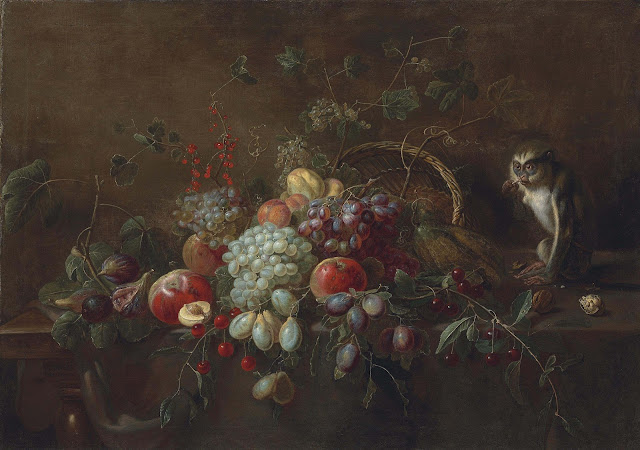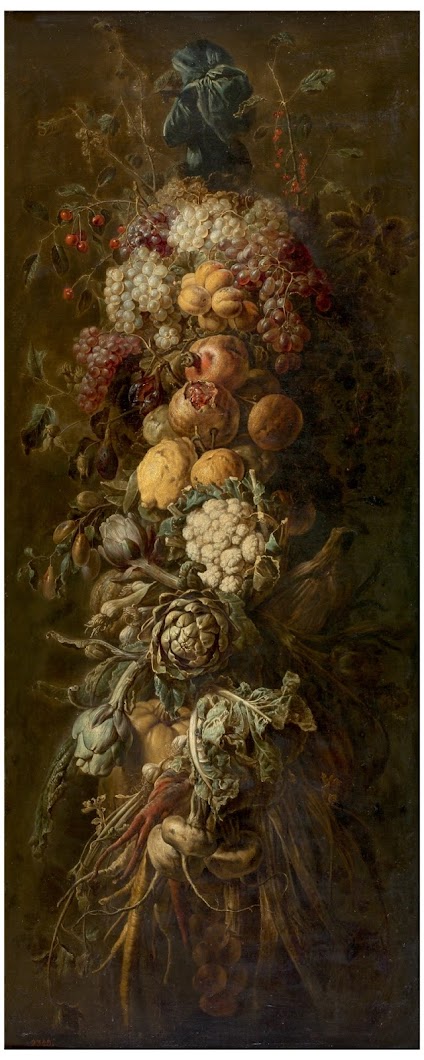 |
| Portrait of Adriaen van Utrecht 1649 engraving by Joannes Meyssens (1612-1670) Rijksmusem, Amsterdam |
Adriaen van Utrecht (Antwerp 1599 – 1652) was a Flemish painter known mainly for his sumptuous banquet still lifes, game and fruit still lifes, fruitgarlands, market and kitchen scenes and depictions of live poultry in farmyards. His paintings, especially the hunting and game pieces, show the influence of Frans Snyders. The two artists are considered the main inventors of the genre of the pronkstillevens, i.e. still lifes that emphasised abundance by depicting a diversity of objects, fruits, flowers and dead game, often together with living people and animals. Van Utrecht also painted a number of flower still lifes. He was a regular collaborator with leading Antwerp painters who had been pupils or assistants of Peter Paul Rubens, such as Jacob Jordaens, David Teniers the Younger, Erasmus Quellinus II, Gerard Seghers, Theodoor Rombouts, Abraham van Diepenbeeck and Thomas Willeboirts Bosschaert.
This is part 1 of 2 on the works of Adriaen van Utrecht:
 |
| 1620s Still Life oil on canvas 67 x 86 cm Private Collection |
 |
| 1620s Still Life detail of the above |
 |
| 1630-40 A lady at the fish market in Antwerp oil on canvas |
 |
| 1630-40 A lady at the fish market in Antwerp detail of the above |
 |
| 1630s Kitchen collaboration with Theodoor Rombouts (1597-1637) oil on canvas 153.5 x 197.5 cm The State Hermitage Museum, St. Petersburg |
 |
| 1630s Kitchen detail of the above |
 |
| c1635 A Basket of fruit on a draped table oil on canvas Private Collection |
 |
| 1636 Still Life with Fruit and a Monkey eating Grapes |
A very similar composition painted eight years later:
 |
oil on panel 81.5 x 116.5 cm |
 |
| 1642 Grapes, apples, plums, figs and other fruit etc. detail of the above |
 |
| 1636 Still life with parrot or Allegory of Fire oil on canvas 117 x 154 cm Royal Museums of Fine Arts of Belgium, Brussels |
 |
| 1636 Still life with parrot or Allegory of Fire detail of the above |
 |
| 1638 Festoon of Fruits and Vegetables oil on canvas 186 x 60 cm Image copyright ©National Prado Museum |
 |
| 1640 Fishmonger's Stall oil on canvas 215.5 x 300.5 cm Museum of Fine Arts Ghent, Belgium |
 |
| c1640-59 Peacock and farmyard birds oil on canvas 176 x 218 cm Louvre, Paris |
 |
| 1640s Garland of Fruit and Vegetables oil on canvas 57 x 84 cm The State Hermitage Museum, St. Petersburg |
 |
| 1640s Still Life with Grapes oil on canvas 119 x 99 cm The State Hermitage Museum, St. Petersburg |
 |
| 1640s Still life with vegetables oil on canvas 74.4 x 118 cm Museum of Fine Arts, Budapest |
 |
| 1641 Still life with fruit piled high in a basket, surrounded by quinces, melons and asparagus on a ledge oil on canvas 67.3 x 86.4 cm |
 |
| 1641 Still-Life oil on canvas 76 x 119 cm Private Collection |
 |
| 1642 A Pantry oil on canvas 221 x 307 cm Museo del Prado, Madrid |
 |
| c1642 Still Life with Bouquet and Skull oil on canvas 67 x 86 cm Private Collection |
 |
| 1644 Banquet still life oil on canvas 186 x 243 cm Rijksmuseum, Amsterdam |
 |
| 1644 Banquet still life detail of the above 1 |
 |
| 1644 Banquet still life detail of the above 2 |
 |
| 1644 Fruit Hangers oil on oak panel 138.4 x 99.7 cm (Centre designed for a mirror) Kunsthistorisches Museum Vienna |
 |
| 1645 A Barn interior with a Turkey oil on canvas 125 x 175 cm |
 |
| 1646 Turkeys and Chickens oil on canvas 121 x 170.2 cm |
 |
| 1646-49 Still-Life with hare and birds on a ring oil on canvas 86 x 117 cm Gemäldegalerie, Dresden, Germany |
 |
| 1647 A Still Life With Grapes, Figs, Apples, Oranges, Apricots, Lemons, A Melon, Loganberries, an Open Pomegranate And Cherries oil on canvas |





















































